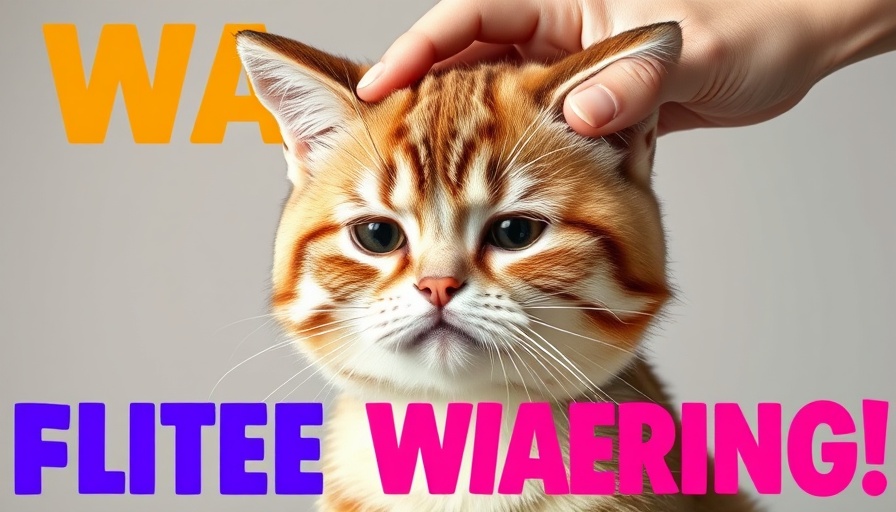
Understanding the Emotional Needs of Your Cat
When it comes to our feline friends, understanding their emotional needs is just as important as tending to their physical well-being. Cats communicate differently than dogs and often express their emotions through subtle cues. Without recognizing these signs, pet parents can unknowingly hurt their cats emotionally. This article explores 15 common behaviors that may be upsetting your cat and offers insightful advice to improve the bond with your beloved pet.
In '15 Everyday Things HURT Your Cat Emotionally!', the discussion dives into the crucial nature of recognizing and nurturing the emotional needs of our feline friends, exploring key insights that sparked deeper analysis on our end.
Why Your Cat’s Trust Is Crucial
Trust is not instantaneous; rather, it is built and nurtured over time. Cats, unlike dogs, have their unique way of developing trust based on their experiences and the energy they receive from their guardians. Rushing this process or failing to earn trust can lead to anxiety and emotional distance. Success lies in patience—allowing your cat to come to you in their own time fosters a safe and loving environment.
The Importance of Recognizing Subtle Signs
Cats are masters of subtlety, often communicating discomfort through small gestures—a flick of the tail, a slight shift in position, or even silence. Understanding this quiet language is a key part of being a responsible cat parent. It’s essential to pay attention to these whispers of emotion; doing so can prevent misunderstandings and promote trust. When your cat feels listened to and safe, they are more likely to approach you for comfort and companionship.
Responding to Behavior with Understanding
When faced with unwanted behaviors such as scratching or knocking things over, your first instinct may be frustration. However, what these actions often reveal is an unmet need. Instead of resorting to punishment, seek to understand the underlying emotion or instinct behind the behavior. This approach not only helps to create a supportive environment but also reduces fear and builds stronger bonds based on empathy and understanding.
Challenging Common Misconceptions
There is a prevalent idea that cats are low-maintenance pets requiring little interaction beyond basic feeding. However, this misconception undermines their need for connection and engagement. Cats thrive on routine, interaction, and mental stimulation. Providing them with enriching environments—like new toys or safe places to observe their surroundings—will enhance their emotional health and keep them engaged.
The Role of Space and Autonomy
Unlike dogs, cats value their independence greatly. They are less inclined to seek affection on demand and often desire space to recharge. Misunderstanding this need can lead to emotional distress for both pet and owner. Allowing your cat the freedom to choose when to engage is essential to cultivating a healthy relationship. Provide a serene space in your home where your cat can retreat and feel safe.
Creating a Calming Home Environment
Cats are sensitive creatures; they thrive in quiet environments. Loud noises, chaotic movements, and even unpleasant smells can disrupt their peace and make them feel unsafe. Therefore, maintaining a calm atmosphere is crucial. Focus on lowering your voice, moving slowly, and protecting your cat from overstimulation. This commitment to creating a serene environment communicates love and understanding, further solidifying the bond of trust.
Maintaining Care Rituals for Emotional Health
One of the best ways to show care for your cat is through consistent, gentle attention. Daily rituals, whether it's a quiet cuddle on the sofa or a dedicated play session, can reinforce feelings of security. Try incorporating predictability into your interactions so that your cat learns to trust your presence. Engaging in short, interactive playtime stimulates their natural instincts and encourages a joyful heart.
Building Trust Through Daily Interaction
The heart of cat care lies in understanding their unique emotional landscapes. Cats thrive on routine and gentle interactions that signal safety and connection. A constant presence of love, reflected through mindful engagement, eating habits, and environmental enrichment, allows them to flourish into emotionally stable companions. Finally, remember that even hushed moments of silence can hold significance as you bond with your cat, ensuring they receive the care they deserve in a way that honors their unique spirit.
Conclusion: The Next Steps in Your Cat’s Emotional Wellness
As responsible pet parents, we can always do better to nurture our pets' emotional well-being. By applying patience and willing to learn from our cats, we may discover the true essence of trust and companionship. Embrace their unique perspectives and needs, and you will cultivate a bond that goes beyond mere ownership—it blossoms into a heartfelt partnership. Have you made any observations regarding your cat’s emotions? Share your experiences below and let's foster a supportive community for all pet parents.
 Add Row
Add Row  Add
Add 




Write A Comment